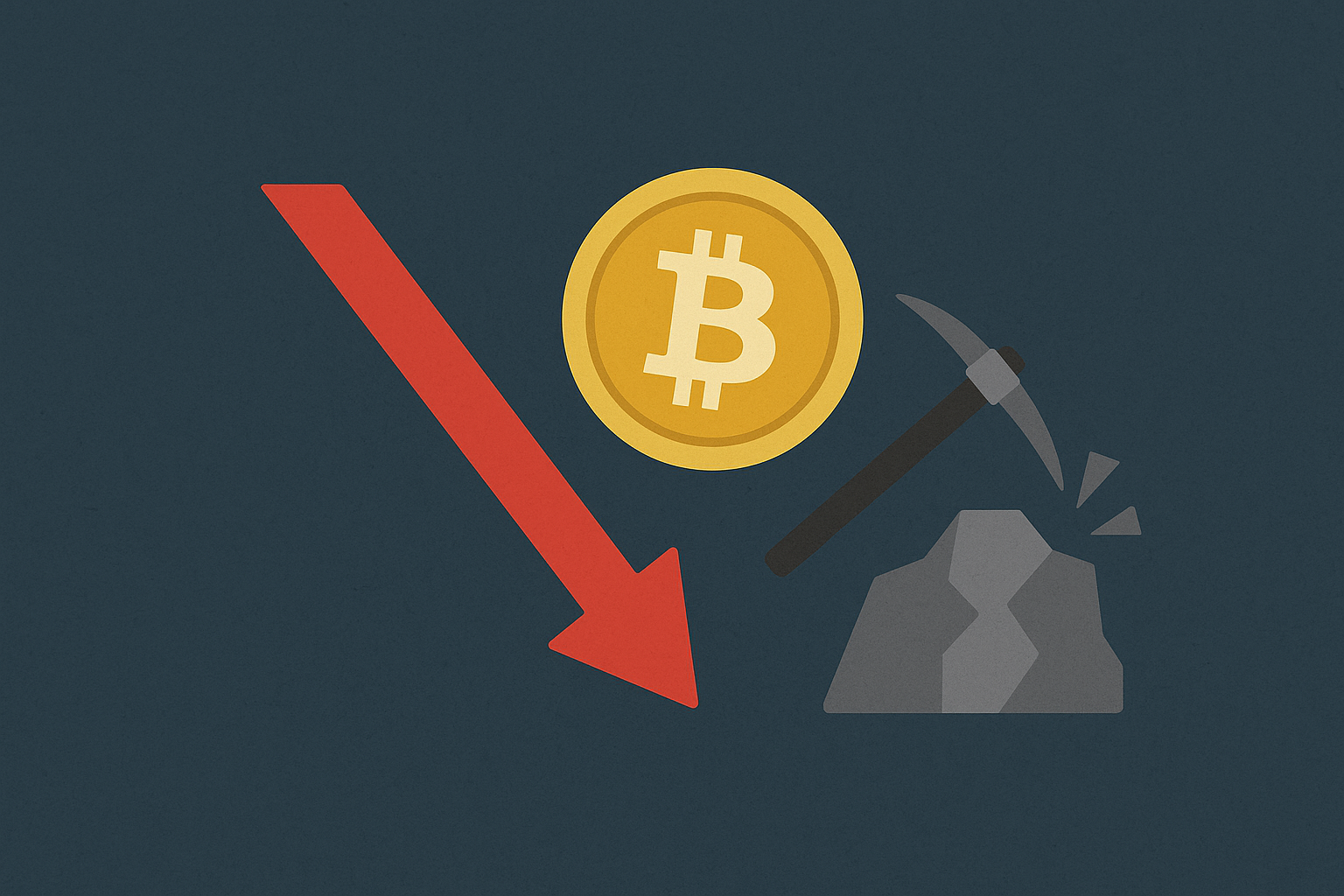Bitcoin
Bitcoin Mining Difficulty Drops Again In June — Deep Dive Into Its Implications

Introduction
In the ever-evolving ecosystem of cryptocurrency, Bitcoin mining difficulty is a crucial metric that often flies under the radar of mainstream discourse. Yet, for those who follow the crypto markets and blockchain performance closely, it represents a key indicator of network health, miner behavior, and potentially even price movements. In June 2025, Bitcoin’s mining difficulty has now dropped twice in a single month, raising questions about what this change signals in a broader context. Is it merely a technical correction, or does it hint at deeper shifts within the network’s foundation?
This article takes a long-form look into the latest difficulty drop, examining what mining difficulty really is, why it matters, the historical context, the underlying causes of the current change, and how it might influence miners, the market, and the security of the Bitcoin blockchain going forward. Drawing from expert analysis, miner sentiment, and real-time blockchain data, we present a comprehensive breakdown of what this development means for stakeholders across the board.
Understanding Bitcoin Mining Difficulty
Before diving into recent developments, it’s important to grasp what mining difficulty actually refers to. In the Bitcoin network, difficulty is a measure of how hard it is to find a new block. This level is dynamically adjusted every 2,016 blocks (approximately every two weeks), depending on the total computational power—or hash rate—being contributed by miners globally.
The purpose of adjusting the difficulty is to ensure that blocks are produced roughly every 10 minutes, maintaining consistency in transaction processing. If miners leave the network and the hash rate drops, the difficulty adjusts downward to keep block production steady. Conversely, if more miners join and the hash rate increases, the difficulty rises.
Thus, a drop in difficulty typically signals a decline in mining power, which can happen for various reasons: reduced profitability, hardware failure, regulatory crackdowns, energy costs, or network migrations.
The June 2025 Dual Drop: A Rare Occurrence
In June 2025, Bitcoin mining difficulty dropped twice, which is relatively uncommon and noteworthy for several reasons. The latest decline, confirmed on June 25, followed an earlier adjustment that occurred earlier in the month. Cumulatively, this represents a significant decrease in mining challenge within a short time span, prompting analysis from both market observers and network participants.
According to CryptoPotato and other data aggregators like BTC.com and CoinWarz, the overall difficulty adjustment over the two periods saw a combined drop of more than 7%, placing it among the larger recent back-to-back reductions. Historically, consecutive drops are associated with miner exits or reduced network activity. This can occasionally happen during bear markets, after halving events, or in response to global economic stressors.
Why Is Mining Difficulty Dropping?
There are multiple factors contributing to the recent decline in difficulty. Analysts and mining insiders point to a convergence of pressures that are currently squeezing mining operations:
1. Declining Bitcoin Prices
Throughout June, Bitcoin’s price has remained under downward pressure, recently slipping below the $60,000 threshold after months of sideways movement. While this is still high historically, many mining operations, particularly those with higher operational costs, struggle to remain profitable when prices fall and electricity rates stay the same or increase.
Lower Bitcoin prices directly impact miner profitability, as their revenue—denominated in BTC—shrinks in fiat terms. This discourages marginal miners or those with outdated hardware from continuing operations, leading to a collective reduction in network hash rate.
2. Post-Halving Profit Compression
Bitcoin underwent its fourth halving in April 2024, reducing the block reward from 6.25 BTC to 3.125 BTC. While market expectations often price in halvings well in advance, the actual reduction in block rewards has a tangible impact on miners’ bottom lines.
For many, especially those who failed to upgrade to newer, more efficient ASICs, the halving has pushed operations toward or below break-even. The effects of the halving are cumulative and often manifest over months, and by mid-2025, some miners are finally capitulating.
3. Regulatory Uncertainty and Energy Crackdowns
Another factor is the increasing regulatory scrutiny around crypto mining, especially in regions like the U.S., Canada, and parts of Europe. Several jurisdictions are proposing or implementing caps on energy consumption by mining farms or levying extra taxes on high-energy blockchain operations. This has led to shutdowns or relocations of mining infrastructure to more favorable environments.
There are also ongoing issues in energy-sensitive regions like Kazakhstan and Iran, where intermittent energy availability and new policy constraints have caused localized hash rate reductions.
Implications For Miners
The most direct impact of a difficulty drop is on active miners. With fewer competitors, each miner who remains online faces less difficulty in discovering blocks, thus increasing their share of block rewards—at least temporarily.
However, the broader reality is more complex. Many miners interpret repeated difficulty drops as a warning sign of systemic stress within the mining ecosystem. It suggests that the business model is under strain and that further consolidation is likely. Well-capitalized mining firms with access to cheap energy and advanced hardware may view this as an opportunity to gain more market share. Conversely, smaller operations could face growing challenges.
This situation could further centralize mining power, which poses risks to network decentralization and resilience.
What It Means For The Bitcoin Network?
At the protocol level, a drop in mining difficulty does not compromise the Bitcoin network—in fact, it’s a built-in safeguard that keeps the blockchain functioning efficiently. Nevertheless, it does carry implications for network security and decentralization.
Bitcoin relies on computational power to secure the network against attacks, including the infamous 51% attack scenario. When hash rate declines significantly, in theory, it becomes easier and cheaper to attempt such attacks, though in practice this remains unlikely due to Bitcoin’s global miner distribution and high base-level hash power.
More significantly, continued drops in difficulty—especially if tied to regional shutdowns or policy restrictions—could lead to centralization of mining power, where only a handful of players control a large portion of the hash rate. This could erode trust in the system over time, particularly if governance debates emerge around protocol upgrades or soft forks.
Potential Market Reactions
The Bitcoin market often reacts indirectly to mining difficulty shifts. While not a front-page metric for traders, it can serve as a sentiment barometer. Repeated difficulty drops can signal miner capitulation, which in past cycles has often preceded price bottoms.
Market participants will be watching closely to see if this technical signal aligns with broader macroeconomic recovery, Bitcoin accumulation trends, and ETF inflows. If history repeats, a period of declining difficulty and hash rate could represent the calm before a new bullish wave, especially as weak hands exit and strong players consolidate their positions.
At the same time, a more pessimistic view would suggest that continued mining weakness mirrors a lack of confidence in the current price level and suggests further downside risk.
Expert Commentary: A Divided Outlook
Industry experts and commentators are divided on what this latest adjustment means long-term.
Jameson Lopp, CTO of Casa, noted that “Difficulty drops should not immediately be interpreted as bearish—rather, they are a rebalancing of incentive structures built into the protocol. Smart miners use this period to optimize.”
Meltem Demirors, Chief Strategy Officer at CoinShares, argued that “While the reduction in difficulty is helpful to existing miners, the broader picture is concerning. We’re seeing the economic strain post-halving materialize into tangible exits. This could drag on into the next quarter.”
Foundry USA, one of the largest North American mining pools, published a statement acknowledging reduced hash rate participation and warning of more volatility ahead if regulatory energy policies are not adjusted.
A Historical Comparison: What Happened In 2022 And 2020?
Looking back, similar multi-phase difficulty drops have occurred before. In May 2022, during the Terra-LUNA collapse and the ensuing crypto crash, Bitcoin mining difficulty dropped sharply as mining profitability was crushed. A comparable pattern followed in March 2020 during the COVID-19-related market shock.
In both instances, the drop in difficulty marked a short-term setback, but also a reset phase that allowed stronger players to re-enter and stabilize the network. Historical data suggests that extended declines in difficulty are often followed by consolidation and eventual recovery—though timing is always uncertain.
What Comes Next?
Going forward, the outlook for Bitcoin mining difficulty—and mining health overall—will depend on several factors:
Price Stabilization or Recovery: If BTC price rebounds above $60,000 and resumes an uptrend, profitability will improve and hash rate could climb again.
Policy Environment: Jurisdictions with large mining footprints will influence the global hash rate trajectory through energy regulation and tax policy.
Technological Upgrades: The adoption of newer, more efficient mining hardware (such as Bitmain’s S21 series) could allow miners to maintain profitability even under compressed rewards.
Global Events: Energy markets, interest rates, and macroeconomic stability will continue to influence miner decisions, especially for industrial-scale operations.
Conclusion
Bitcoin’s mining difficulty is more than just a technical metric—it’s a reflection of economic sentiment, market stress, and network resilience. The dual difficulty drop in June 2025 is a signal worth paying attention to. While not catastrophic, it highlights a moment of transformation within the mining sector.
For miners, this is both a warning and an opportunity. For investors, it’s a signal to watch, as technical metrics begin to align with broader market narratives. And for the Bitcoin network as a whole, it’s a reminder that adaptability is built into the code, but human decisions will shape how that adaptability plays out in real time.
Whether this difficulty dip marks a turning point or just a passing phase remains to be seen—but one thing is certain: Bitcoin’s mining landscape is shifting, and its implications will ripple across the crypto ecosystem in the months ahead.











